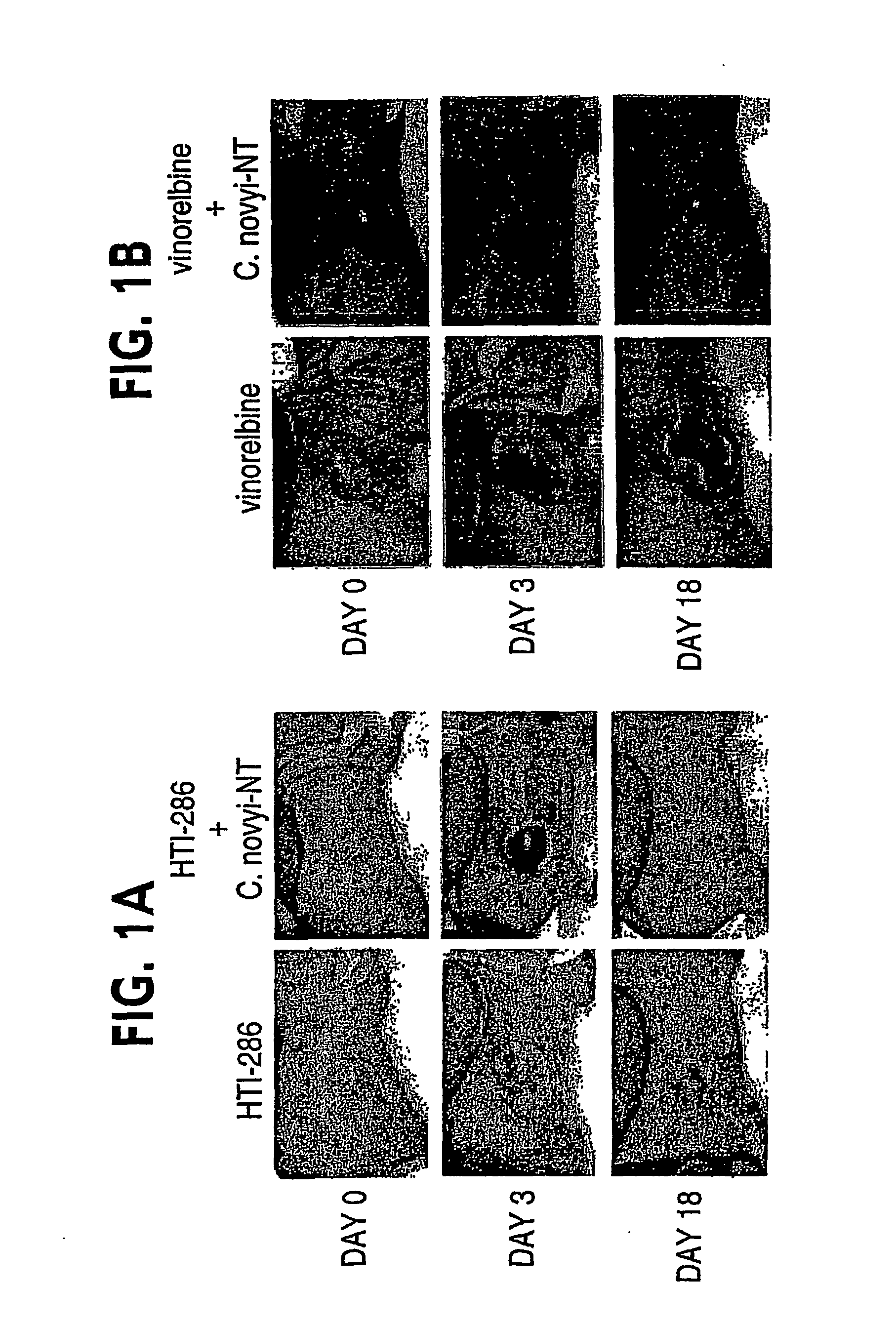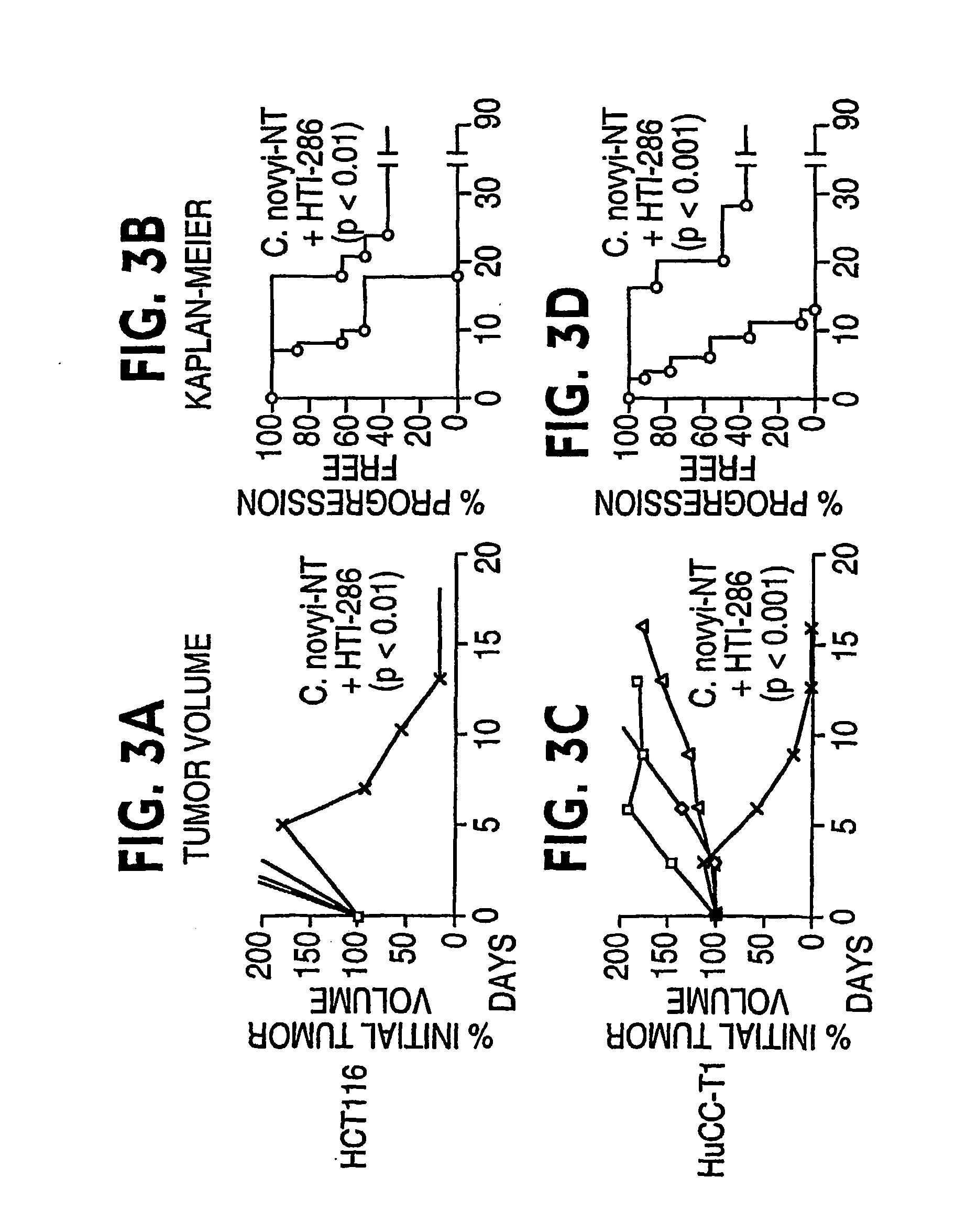Combination bacteriolytic therapy for the treatment of tumors
a bacteriolytic therapy and tumor technology, applied in the field of oncology, can solve the problems of large regions that are poorly vascularized, major problems for oncologists, and the impact of the revolution on the treatment of common solid tumors
- Summary
- Abstract
- Description
- Claims
- Application Information
AI Technical Summary
Benefits of technology
Problems solved by technology
Method used
Image
Examples
example 1
Materials & Methods
Drugs
[0042] Dolastatin 10, auristatin 15-PE, auristatin PYE, and pancratistatin 7-O-phosphate were synthesized by Dr. G. R. Pettit (Cancer Research Institute, Arizona State University, AZ) (Pettit, 1997). Discodermolide, (+)-14-normethyldiscodermolide synthesized by Dr. A. Smith (University of Pennsylvania, Pa.) (Smith et al., 2000). Epothilone B was synthesized by S. Danishevsky, Memorial Sloan-Kettering Cancer Center, New York, N.Y. (Altmann, 2003). HTI-286 [N,β,β-trimethyl-L-phenylalanyl-N1-[(1S,2E)-3-carboxy-1-isopropylbut-2-enyl]-N1, 3-dimethyl-L-valinamide] was synthesized at Wyeth Research, Pearl River, N.Y. (Loganzo et al., 2003). MAC-321 [5β, 20-epoxy-1, 2α-, 4-, 7β-, 10β-, 13α-hexahydroxytax-11-en-9-one 4 acetate 2 benzoate 7 propionate 13-ester with (2R, 3S)-N-tertbutoxycarbonyl-3-(2-furyl)isoserine] (Sampath et al., 2003) was synthesized by Taxolog, Inc (Fairfield, N.J.). Combretastatin A4P and D-24851 were synthesized by Saeed Khan, Sidney-Kimmel C...
example 2
Comparison of Microtubule-interacting Chemotherapeutic Agents
[0049] The timing, route, and dose of agents are critical for the success of any experimental therapy. When two agents are combined, the number of variables that must be tested increases exponentially. To simplify interpretation of the comparisons between various anti-microtubule agents, pilot studies with representative drugs were performed. Based on the optima found through these pilots, the following protocol was implemented: (i) several doses of each chemotherapeutic agent were tested, up to a maximum of the LD50; (ii) the dose of C. novyi-NT was 3×108 spores; and (iii) the chemotherapeutic agents and bacterial spores were mixed in a total volume of 300 to 500 μl and injected intravenously. This joint administration was selected for convenience, as it was found that administration of representative chemotherapeutic agents within several hours before or after the administration of bacterial spores was as efficacious as...
example 3
Mechanisms Underlying the Two Classes of Responses
[0055] We sought to determine the basis for the differences in responses observed with the two classes of microtubule-interacting drugs, represented by HTI-286 and docetaxel, when used in conjunction with C. novyi-NT. It has previously been shown that some microtubule-interacting drugs, particularly those that inhibit microtubule synthesis such as DMXAA and combretastatin A4P, inhibit tumor blood flow (Baguley, 2003) (Tozer et al., 2002). To test whether HTI-286 and docetaxel affected blood flow, we treated HCT116 tumor-bearing mice with these drugs, then intravenously injected the cell-permeable DNA-binding dye Hoechst 33342 two minutes prior to sacrifice. Hoechst predominantly labels the nuclei of endothelial cells in such experiments, as the dye does not have time to diffuse through the tissue during the interval between injection and sacrifice (Bermsen et al., 1999). Frozen sections of the tumors revealed that blood flow to the ...
PUM
 Login to View More
Login to View More Abstract
Description
Claims
Application Information
 Login to View More
Login to View More - R&D
- Intellectual Property
- Life Sciences
- Materials
- Tech Scout
- Unparalleled Data Quality
- Higher Quality Content
- 60% Fewer Hallucinations
Browse by: Latest US Patents, China's latest patents, Technical Efficacy Thesaurus, Application Domain, Technology Topic, Popular Technical Reports.
© 2025 PatSnap. All rights reserved.Legal|Privacy policy|Modern Slavery Act Transparency Statement|Sitemap|About US| Contact US: help@patsnap.com



